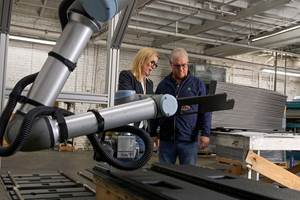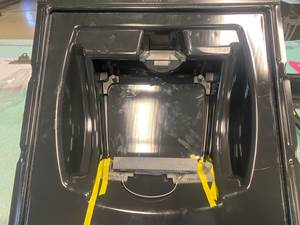Making Gains in the Drain Game
AWD blends extrusion and thermoforming technologies with plenty of home-brewed equipment and processes to keep water away from where it isn’t supposed to be.
Probably ever since humankind first discovered the need for shelter, folks have been trying to move water from here to there. And that’s been the business of American Wick and Drain (AWD) for more than 40 years.
Owned and operated by two families, AWD was launched in 1980. Recalls Scott Morris, the company’s president and part of its second-generation ownership team, “but we soon realized it didn’t make sense to import wick drains, which were relatively simple to manufacture.” So, in 1982, AWD opened a headquarters and production plant in Stallings, North Carolina, then moved to Monroe in 1988, where it has consistently added production capacity and developed new products.

(l-r) AWD President Scott Morris; Marsha Jarvis, customer service and key accounts manager; Khalid Bey, plant manager; and German Valdes, general manager. Source (all photos): AWD
“For centuries, civilizations have been developing technologies to create air space for various purposes such as draining water out of fields to other structures,” he says, “and that’s been driving us since we launched our first product, a formed core and fabric. The fabric restricts the passing of soil particles but allows the flow of water to the core, which forms a prefabricated air space to allow the flow of water.”
In 2006, AWD expanded its footprint to the west with a new plant in Carson City, Nevada. Its product lines include prefabricated single and double-sided sheet drain, strip drain, chimney drain, combination drain and prefabricated vertical drain. It also makes patented fittings and accessories to provide a complete drainage system solution.
Wick drains are used in soil consolidation, explains German Valdes, AWD’s general manager. They are profile extrusions; flat extruded strips with channels that are wrapped by a geotextile filter. Before construction, a site must be dried so a wick drain, typically about 4-inches wide and about ¼-inch thick, is installed vertically about 40- to 80-feet deep into the soil. They are typically installed about 4 feet apart in a grid pattern. The drains shorten the pore water drainage path, permitting the soil consolidation to occur, typically in weeks instead of years. The drain is “sacrificial” in the sense that it is never extracted; once the soil is settled and the water is removed, construction can begin.

AWD runs numerous extrusion lines at its plants in North Carolina and Nevada, and recently commissioned a new sheet line from Davis-Standard.
Primarily used in infrastructure projects, Morris says AWD is the largest manufacturer of wick drains in the U.S., but in 1984 it began producing geocomposite sheet drains. Sheet drains are typically found on a vertical foundation wall. These start out as 4-feet-wide extruded sheets with a geotextile lamination. As Valdes explains, the purpose of the geotextile laminate is to keep soil out of the plastic core and filter out the fines. “This lets the water flow into the core. From there, the water goes down the wall, and is taken away with the footing drains,” which are basically pipe. AWD estimates that wick drains currently comprise 15% of its overall business, with sheet drains taking up roughly 65% of the rest.
As for the remainder, AWD also makes strip drains. These are 1-inch-thick profile extrusions that are completely wrapped in fabric and come in widths of 6 and 12 inches, and are used as an alternative to corrugated pipe.
At each of its plants, AWD has an undisclosed number of lines to produce profile and sheet extrusions. AWD recently commissioned a Davis-Standard sheet line for its Monroe plant. It typically runs sheet inline with BMG (formerly Brown Machine Group) thermoformers. The company also utilizes a variety of proprietary offline processes to finalize the finished products.

AWD got into the sheet strip-drain business in 1984. Shown here is a sheet extrusion and a thermoformed core with a geotextile lamination.
In both its wick and sheet drain product lines, AWD has a half-dozen or so competitors. But it believes having multiple manufacturing processes and locations on both coasts give AWD a competitive advantage. Says Valdes, “We have more manufacturing flexibility because of the equipment that we have, some of which we buy, some of which we develop ourselves. Whereas most of our competitors, they have a manufacturing process, we have many.” Adds Morris, “Of our competitors, we are the only ones with manufacturing capabilities on both sides of the country. And our business has expanded beyond the U.S. because of this level of flexibility. We have customers in Canada, Mexico and have gone as far as India and Hong Kong.”

Strip drains are thermoformed extrusions wrapped in fabric and used as an alternative to corrugated pipe.
On the sheet-drain side, products are driven by industrywide specifications. Valdes estimates there are roughly five core products, which as a result enables AWD to produce and inventory sheet in anticipation of demand.
And business has been robust at AWD, with Morris pointing to a 37% increase in revenue over the past few years. Morris attributes parts of this increase to his state’s appeal as a manufacturing and residential site.
Focus on Sustainability
WD became focused on sustainability long before the term came into vogue. Fully 100% of the polymer it uses to make its products is postindustrial reclaim, PP- and HIPS-based. Valdes would divulge neither the source of his reclaim nor the quantity AWD buys. He notes: “But we have some partners that we had developed over the years. Getting the right suppliers is difficult. But every pound we receive is certified to our specifications. And we have worked with the recyclers to help them develop and refine their processes where the incoming material quality is consistent and steadily improving.”

Applications for AWD’s drainage products include roadway edge drains as shown here.
In its lab in North Carolina, AWD has a small extruder that runs samples for in-house testing. “If something is a little off, we know it can go back to our recycler and say, ‘Hey, we might have an issue over here. Go back to the drawing board and check it out.’”
“Of our competitors, we are the only ones with manufacturing capabilities on both sides of the country.”
AWD is also constantly in search of more sustainable options among its fabrics, looking at cases where 100% virgin material might not be necessary. And Valdes points to an unspecified ongoing project that, when completed, will get AWD “very close to neutral carbon emissions.”
Eric Horstman, AWD’s director of sales, puts it this way: “We’ve innovated a lot since our first product in 1982, our prefabricated vertical drain (wick) which was a formed core and fabric. We’ve rounded out our product line with prefabricated strip drains that can replace pipe and stone, giving a building head-to-toe drainage in such applications as horizontal backfilled walls and blindside walls, in addition to plaza decks, green roofs and under- slab applications.
“And we started to perforate the core for a double-side drainage in civil applications to allow water to flow from all directions. This innovation led to a green roof drainage and water reservoir to retain water for plant life and allow overflow to be taken away.

AWD has developed a high-performance pattern for “entangled mesh” technology to meet the demands of the applications it serves.
“But it does not end with a dimpled or wick air space. The shareholders continue to push the envelope of airspace with the development of the ability to create another airspace with an ‘entangled mesh.’ As a result, AWD can offer customers technical platforms with various products to meet the designer needs, and installers the ability to have the product of choice for a successful application.”
Related Content
Cobot Creates 'Cell Manufacturing Dream' for Thermoformer
Kal Plastics deploys Universal Robot trimming cobot for a fraction of the cost and lead time of a CNC machine, cuts trimming time nearly in half and reduces late shipments to under 1% — all while improving employee safety and growth opportunities.
Read MoreOrigin Materials Unveils CapFormer for Producing PET Caps
Factory acceptance test completed at commercial scale.
Read MoreThermoformer Maximizes Productivity with 3D Printing
Productive Plastics has created an extensive collection of 3D printed manufacturing aids that sharply reduce lead times.
Read MoreAmcor, Berry Merge in All-Stock Deal
Move unites two complementary businesses to create a global leader in consumer packaging.
Read MoreRead Next
See Recyclers Close the Loop on Trade Show Production Scrap at NPE2024
A collaboration between show organizer PLASTICS, recycler CPR and size reduction experts WEIMA and Conair recovered and recycled all production scrap at NPE2024.
Read MoreMaking the Circular Economy a Reality
Driven by brand owner demands and new worldwide legislation, the entire supply chain is working toward the shift to circularity, with some evidence the circular economy has already begun.
Read MoreLead the Conversation, Change the Conversation
Coverage of single-use plastics can be both misleading and demoralizing. Here are 10 tips for changing the perception of the plastics industry at your company and in your community.
Read More














